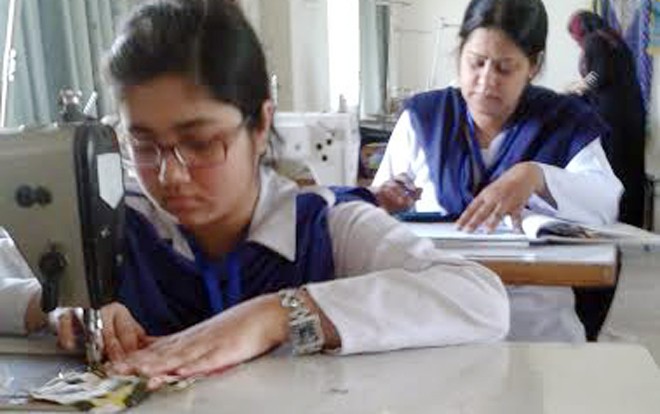
Vocational training is enabling women to earn an income and set up businesses

Ghazala Anwar, 23, never studied after tenth grade. A year-long diploma course which she has enrolled in will teach her the skills needed to start her own beauty salon.
Anwar is taking regular classes at the Sindh Technical Education Vocation Training Authority (TEVTA) in Karachi. She happens to be one of the 500 girls who are learning skills that may guarantee them jobs.
"I can earn a living without having a university degree," she says. "Also, my family has agreed to help me start a salon as I will only be dealing with female customers."
Every girl is not meant to become a doctor or engineer. Despite that they can contribute to the economy without having to step out of their social structure. This is the philosophy behind vocational training being offered by the Sindh government.
Under the Sindh government’s initiative, three centres based in Bufferzone, New Karachi and Korangi, the lower middle class areas of Karachi are imparting vocational training to women aged 15-40.
Courses include cutting and sewing, computer training, architecture, Montessori teaching, and beautician skills.
The Bufferzone centre spread over 30 huge rooms is teeming with girls of all ages. The boutique section has the largest strength of students. Some cutting clothes, others busy at the sewing machine.
Fazeela, a student, says once she completes her diploma she will apply for a job at a boutique. "I love clothes. It will be nice to earn a living where I can stitch clothes for people," she says.
Students run a salon and a boutique inside the centre, which is frequently visited by women from the neighbourhood. They also offer yoga classes and aerobics.
Nahid Azim, principal of the institute, says these short courses are meant for women who either cannot afford a university degree or those who need instant employment. "Single-income families do not work anymore. Women have to work to run the house. Short courses like the ones we provide here equip women with instant money-making skills."
"There are widows in Karachi who need to fend for themselves. We help such women live a respectable life," says Azim.
She maintains that with technological advancements women with young children do not even need to step out of their house to earn a living. "I have many students who design websites and architectural maps on the computer for clients based in the US."
Zarqa Saeed, assistant director of the programme, says vocational training produces entrepreneurs and not just "job-seekers" in the market. "This is how economies work. Everyone cannot wait to rely on the service sector and huge multinational companies to provide them jobs. One has to be an entrepreneur."
She laments, however, that vocational training has not received respect in society. "Being a beautician, for example, is not as respectable as being an office clerk. When mothers look for prospective wives for their sons a doctor bride tops their list. Even though she might never practice her profession, she remains a status symbol."
Though Sindh TEVTA has been around since 2009 and claims to provide 40,000 trainings every year, other players in the private sector have sprouted. They include the Hunar Foundation, AmanTech and iAct run under Habib University.
However, so far, government certification is the cheapest, about Rs200 per month, and is also recognised outside Pakistan.